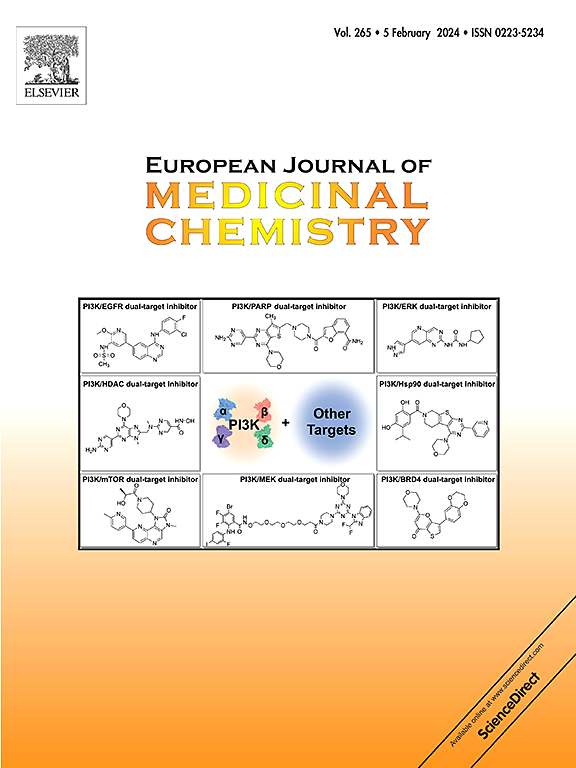Mitochondrial-targeted iridium(III) complexes suppress tumor growth through inducting immunogenic cell death to activate immune response
IF 5.9
2区 医学
Q1 CHEMISTRY, MEDICINAL
引用次数: 0
Abstract
A new ligand, 2-(2-hydroxyl-4-methyl)phenyl-1H-imidazo[4,5-f][1,10]phenanthroline (IPMP), and [Ir(ppy)2(IPMP)]PF6 (7a), [Ir(bzq)2(IPMP)]PF6 (7b), and [Ir(piq)2(IPMP)]PF6 (7c) have been prepared and characterized by HRMS, NMR spectra. The 3-(4,5-dimethylthiazol-2-yl)-2,5-diphenyltetrazolium bromide (MTT) assays revealed that 7b exhibited excellent activity (IC50 = 4.5 ± 0.4 μM), while 7a and 7c showed good cytotoxicity (IC50 = 8.5 ± 0.9 μM and 8.9 ± 2.2 μM) against non-small cell lung cancer A549 cells. The experiments of cellular uptake and mitochondrial localization demonstrate that these new iridium(III) complexes are readily taken up by A549 cells and accumulate in the mitochondria and damage the structure of the mitochondria, which results in the loss of mitochondrial membrane potential (MMP), elevated lipid peroxidation, as well as DNA damage, the inhibition of microtubule polymerization, hindrance of the cell cycle in the G0/G1 phase, and release of cytochrome c, collectively leading to apoptosis. Furthermore, upregulation of Beclin-1, overexpression of NF-κB and downregulation of GPX4 protein were observed, which resulted in the activation of autophagy, pyroptosis and ferroptosis, respectively. In the C57BL/6 mouse model, the 7b demonstrated promising in vivo antitumor efficacy, with a tumor inhibitory rate of 66.9 %. Additionally, the complexes induce an immunogenic cell death to activate immune response, further enhance CD8+ T cells and efficiently inhibit tumor growth. Collectively, we consider that the complexes may be utilized as potential candidate agents for the treatment of A549 cancer.


线粒体靶向铱(III)复合物通过诱导免疫原性细胞死亡激活免疫反应抑制肿瘤生长
制备了一种新的配体2-(2-羟基-4-甲基)苯基- 1h -咪唑[4,5-f][1,10]菲罗啉(IPMP)和[Ir(ppy)2(IPMP)]PF6 (7a)、[Ir(bzq)2(IPMP)]PF6 (7b)和[Ir(piq)2(IPMP)]PF6 (7c),并用HRMS、NMR谱对其进行了表征。3-(4,5-二甲基噻唑-2-酰基)-2,5-二苯基溴化四唑(MTT)实验表明,7b对非小细胞肺癌A549细胞具有良好的活性(IC50 = 4.5±0.4 μM),而7a和7c对非小细胞肺癌A549细胞具有良好的细胞毒性(IC50 = 8.5±0.9 μM和8.9±2.2 μM)。细胞摄取和线粒体定位实验表明,这些新的铱(III)复合物很容易被A549细胞吸收并在线粒体中积累,破坏线粒体结构,导致线粒体膜电位(MMP)丧失,脂质过氧化升高,DNA损伤,抑制微管聚合,阻碍细胞周期在G0/G1期,释放细胞色素c。共同导致细胞凋亡。Beclin-1上调,NF-κB过表达,GPX4蛋白下调,分别导致细胞自噬、焦亡和铁亡的激活。在C57BL/6小鼠模型中,7b显示出良好的体内抗肿瘤效果,肿瘤抑制率为66.9%。此外,这些复合物诱导免疫原性细胞死亡,激活免疫应答,进一步增强CD8+ T细胞,有效抑制肿瘤生长。总的来说,我们认为这些复合物可能被用作治疗A549癌症的潜在候选药物。
本文章由计算机程序翻译,如有差异,请以英文原文为准。
求助全文
约1分钟内获得全文
求助全文
来源期刊
CiteScore
11.70
自引率
9.00%
发文量
863
审稿时长
29 days
期刊介绍:
The European Journal of Medicinal Chemistry is a global journal that publishes studies on all aspects of medicinal chemistry. It provides a medium for publication of original papers and also welcomes critical review papers.
A typical paper would report on the organic synthesis, characterization and pharmacological evaluation of compounds. Other topics of interest are drug design, QSAR, molecular modeling, drug-receptor interactions, molecular aspects of drug metabolism, prodrug synthesis and drug targeting. The journal expects manuscripts to present the rational for a study, provide insight into the design of compounds or understanding of mechanism, or clarify the targets.

 求助内容:
求助内容: 应助结果提醒方式:
应助结果提醒方式:


